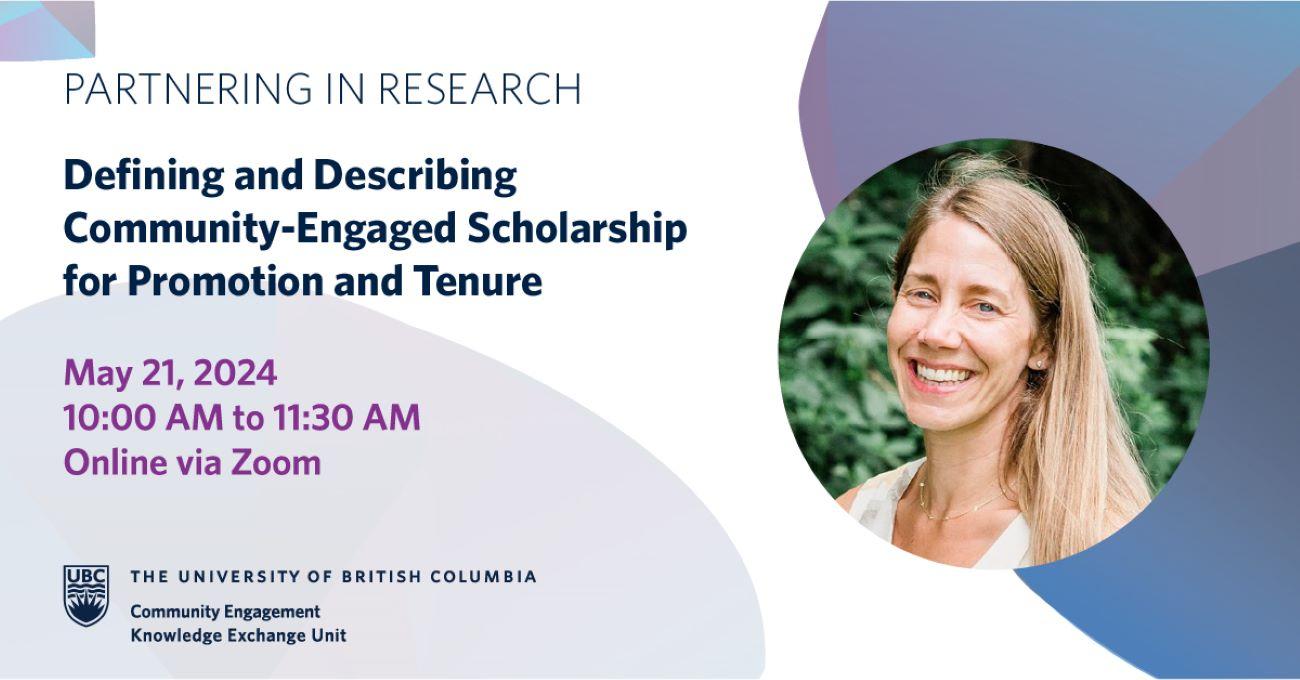
This workshop was part of the University of British Columbia’s Partnering in Research (PiR) professional development workshop series, designed for UBC researchers, students, and staff involved in partnered research, as well as community partners collaborating with UBC for community-centred change. PiR is a collaborative venture between the Knowledge Exchange Unit and Indigenous Research Support Initiative of UBC’s Vice President Research and Innovation, the Office of Community Engagement under the Vice President External Relations, and the Centre for Asian Canadian Research and Engagement in the Faculty of Arts.
On Tuesday, May 21, 2024, Dr. Emily Janke led an insightful workshop titled, “Defining and Describing Community Engaged Scholarship for Promotion and Tenure” about the nuances of presenting and evaluating community-engaged scholarship.
Vice Provost Academic, Moura Quayle, warmly welcomed Emily’s expertise in the context of the work UBC is doing to support engaged scholars. With 20 years of experience as a scholar-administrator, Emily’s work addresses multiple aspects of community engagement focused on community-university partnerships, institutional culture, and change strategies.
During the workshop, participants gained practical advice on how to craft effective scholarly narratives so that department heads and review committees better understand the process of community engagement and how its distinguishing features must be factored into evaluations for promotion and tenure decisions.
This sold-out event garnered 144 registrations from faculty, staff, students and external partners from across Canada, the US and as far away as Australia. The popularity of the event conveyed immense interest in this conversation, particularly among early career researchers who struggle to articulate the value of their community-engaged scholarship for promotion and tenure.
Watch the Talk
Key Takeaways on how to describe impactful engaged scholarship
Dr. Emily Janke shared valuable insights on how faculty can effectively craft their scholarly narratives. Here are some key points we compiled:
Expanding Forms of Scholarship
Traditionally, scholarship has centered on tangible artifacts such as books, chapters, and conference presentations. The last decade, however, has seen an expansion in mechanisms of dissemination, including videos, films, blogs, and vlogs. For community-engaged scholars, it is crucial to incorporate these diverse scholarly outputs into their dossiers.
Understanding Reciprocity and Mutually Beneficial Outcomes and How They Differ
Reciprocity is about process and involves viewing community partners as thought partners in the collaborative process. Mutually beneficial outcomes refer to the products – positive impacts for both the community and academia. It is vital to understand the difference between these two distinct ideas that are often used interchangeably.
The Challenge of Evaluating Community Engagement
Engaged scholarship involves reorienting the academy to work collaboratively with communities over the course of research. Evaluating excellence in community engaged research must go beyond traditional metrics of journal publication and encompass measures of reciprocity, shared leadership and responsiveness. Dr. Janke described excellence in collaborative research as “walking alongside” or being “an active follower.”
Dr. Janke introduced the concept of epistemic justice, or epistemic inclusion, valuing knowledge that exists and created outside of the academy. Community-engaged scholars can uphold the ideal of epistemic inclusion as they collaborate with communities and name it as a strength of their research approach.
Assessing Community-Engaged Scholarship Beyond Service
Community-engaged scholarship should be assessed by its process and its commitment to epistemic inclusion. This assessment involves teaching, learning, and service, which are often interconnected and evolve throughout a scholar’s career. Do your engaged scholarship justice by acknowledging relationship development activities (think coffees, meetings, attending community events) as part of Research and Teaching. Your engaged research and/or coursework would not be possible if you didn’t do the important work of nurturing relationships.
Institutional and Policy Reforms
Emily discussed the broader context of supporting public impact within academic institutions and among funders. To enhance public relevance, institutions must reform appointment, retention, tenure, and promotion policies. Clear definitions and descriptions of community engagement that value its outputs, outcomes and processes are essential in crafting a compelling scholarly narrative.
Strategies for Crafting Your Scholarly Narrative
Emily shared that all faculty members struggle to coherently articulate their scholarly engagement. This may be because many engage in diverse forms of scholarship including community-engaged, foundational and/or applied research. It may also be unclear which activities are to be considered service and which constitute scholarly outputs. An additional challenge, particularly for engaged scholarship, is creating narratives that demonstrate clear aims and evidence of success.
She offered strategies to describe scholarly engagement:
- Seek External Input: Ask colleagues or friends who know you well to describe your scholarship and its value
- Describe Your Work: Explain the various activities that form your program of research, drawing explicit links between each activity. Reviewers need to understand how these research engagements connect.
- Define Success: Clearly outline what success means to you, as you may not always rely on citation indexes or prestigious journal names.
- Narrative Components:
- Core Passion: Describe your central motivation
- Areas of Focus: Identify and describe two or three areas of focus within your projects and how they relate to your agenda, distinguishing which are community-engaged.
- Methodology: Explain why you intentionally selected specific approaches
- Collaborators: Define your collaborators as thought partners and co-laborers, highlighting their essential qualities and characteristics that they bring to your scholarly work.
- Audience Impact: Describe how you will reach your audiences, both those within academic and community settings. This will clarify the utility of both practical and traditional scholarly outputs.
- Impact: Discuss your impact, goals, and any products or artifacts that will be produced.
Having trouble getting started? Try these prompts:
- I aim to…
- It matters because…
- I produced…
- I know I’ve been successful because…
By following these strategies, faculty can craft a compelling scholarly narrative that highlights their academic contributions and underscores their work’s practical, positive influence of their work on society.